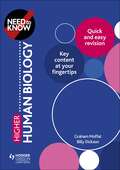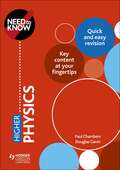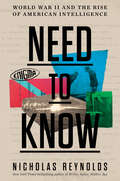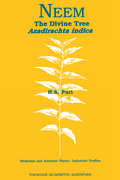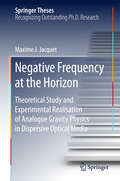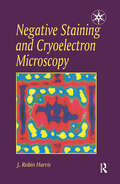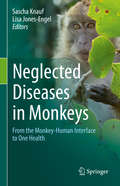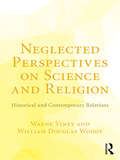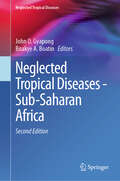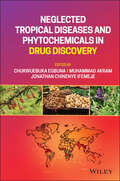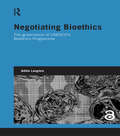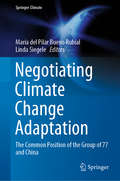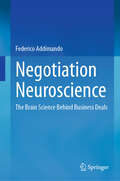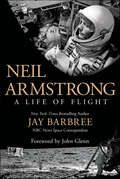- Table View
- List View
Need to Know: Higher Human Biology
by Graham Moffat Billy DicksonExam board: SQALevel: HigherSubject: Human BiologyFirst teaching: September 2018 First exams: Summer 2019 What do you really need to know for the SQA Higher Human Biology exam?This revision guide covers the essentials in less than 100 pages, so it's perfect for early exam preparation or last-minute revision.- Find key content at your fingertips with quick summaries of the concepts, processes and terminology that you need to understand- Get a better grade in your exam with tips on exam technique, mistakes to avoid and important things to remember- Revise and practise using end-of-topic questions and in-depth questions at the end of each section - with answers provided online- Benefit from the knowledge of experienced teachers, examiners and authors Graham Moffat and Billy Dickson
Need to Know: Higher Physics
by Paul Chambers Douglas GavinExam board: SQALevel: HigherSubject: PhysicsFirst teaching: September 2018First exams: Summer 2019What do you really need to know for the SQA Higher Physics exam?This revision guide covers the essentials in less than 100 pages, so it's perfect for early exam preparation or last-minute revision.- Find key content at your fingertips with quick summaries of the concepts, issues and terminology that you need to understand- Get a better grade in your exam with tips on exam technique, mistakes to avoid and important things to remember- Revise and practise using end-of-topic questions and in-depth questions at the end of each section - with answers provided online
Need to Know: World War II and the Rise of American Intelligence
by Nicholas ReynoldsOne of The New Yorker's "Best Books of the Year" * A Gilder Lehrman Military History Prize Finalist"Authoritative. . . . [Reynolds's] contribution to our understanding of the rise of American intelligence is unparalleled." —Journal of Intelligence History“The most thorough and detailed history available on the origins of U.S. intelligence.” —Michael Morell, former Deputy Director and Acting Director, CIAHistorian and former CIA officer Nicholas Reynolds, the New York Times bestselling author of Writer, Sailor, Soldier, Spy, uncovers the definitive history of American intelligence during World War II, illuminating its key role in securing victory and its astonishing growth from practically nothing at the start of the war. The entire vast, modern American intelligence system—the amalgam of three-letter spy services of many stripes—can be traced back to the dire straits the world faced at the dawn of World War II. Prior to 1940, the United States had no organization to recruit spies and steal secrets or launch covert campaigns against enemies overseas and just a few codebreakers, isolated in windowless vaults. It was only through Winston Churchill’s determination to mobilize the US in the fight against Hitler that the first American spy service was born, built from scratch against the background of the Second World War.In Need to Know, Nicholas Reynolds explores the birth, infancy, and adolescence of modern American intelligence. In this first-ever look across the entirety of the war effort, Reynolds combines little-known history and gripping spy stories to analyze the origins of American codebreakers and spies as well as their contributions to Allied victory, revealing how they laid the foundation for the Cold War—and beyond.
Neem: The Divine Tree Azadirachta indica (Medicinal and Aromatic Plants - Industrial Profiles)
by H.S. PuriThis comprehensive review on neem is an excellent collation of observations and research efforts by botanists, taxonomists and medical practitioners and will be of interest to everyone with an interest involved in medicinal and aromatic plant research.
Negative Frequency at the Horizon: Theoretical Study And Experimental Realisation Of Analogue Gravity Physics In Dispersive Optical Media (Springer Theses)
by Maxime J. JacquetThis book is part of a large and growing body of work on the observation of analogue gravity effects, such as Hawking radiation, in laboratory systems. The book is highly didactic, skillfully navigating between concepts ranging from quantum field theory on curved space-times, nonlinear fibre optics and the theoretical and experimental foundations in the physics of optical analogues to the Event Horizon. It presents a comprehensive field-theoretical framework for these systems, including the kinematics governing the fields. This allows an analytical calculation of the all-important conversion of vacuum fluctuations into Hawking radiation. Based on this, emission spectra are computed, providing unique insights into the emissions from a highly dispersive system. In an experimental part, the book develops a clear and systematic way to experimentally approach the problem and demonstrates the construction of an experimental setup and measurements of unprecedented sensitivity in the search for stimulation of the Hawking effect.
Negative Staining and Cryoelectron Microscopy: The Thin Film Techniques
by 0 J.R. Harris,Since the start of biological studies using the transmission electron microscope scientists have sought to develop procedures for the preparation and investigation of the thinly spread specimens of biological particulates. Negative Staining and Cryoelect
Neglected Diseases in Monkeys: From the Monkey-Human Interface to One Health
by Lisa Jones-Engel Sascha KnaufThis book offers a valuable resource, reviewing the current state of knowledge concerning the pathology and epidemiology of infectious diseases in both captive and wild monkeys. The One Health concept forms the framework of all chapters. The multidisciplinary team of authors addresses neglected diseases caused by the three major pathogen groups - bacteria, viruses, and parasites. Moreover, the volume discusses key virulence factors such as the evolution of antibiotic resistance, and the ecological drivers of and human influence on pathogen transmission. Demonstrating how researchers working on monkeys diseases are increasingly thinking outside the box, this volume is an essential reference guide to the field of One Health and will serve as an asset for stakeholders in conservation, healthcare and research organizations that face the challenge of moving beyond classical human oriented approaches to health.
Neglected Perspectives on Science and Religion: Historical and Contemporary Relations
by Wayne Viney William Douglas WoodyNeglected Perspectives on Science and Religion explores historical and contemporary relations between science and religion, providing new perspectives on familiar topics such as evolution and the Galileo affair. The book also explores common differences in science and religion with respect to their various treatments of doubt, curiosity, and the methods by which truth claims are assessed. The book includes discussions of religious and scientific treatments of the origins of males and females, evolving views of sex and gender, and contemporary tensions about topics such as same-sex marriage. Viney and Woody also include a chapter exploring the effects of social science research on religious topics such as prayer, prejudice, and violence. The rise of social sciences such as psychology, sociology, and anthropology has resulted in discoveries that contribute to new ways of thinking about the relations of science and religion. This book is ideal for graduate and upper-level undergraduate students, as well as anyone interested in science and religion.
Neglected Plant Foods Of South Asia: Exploring and valorizing nature to feed hunger
by Tariq Ismail Saeed Akhtar Claudia E. LazarteAccording to the global hunger index, South Asia has worldwide highest rate of undernourished people. Such a burden of food insecurity and various forms of malnutrition are directly associated with the existing food production system that ignores biodiversity, food affordability, and sustainability. During the last five decades, food production system has witnessed a global shift from ethnic to mainstream staple cereals production and promotion. Such an approach has badly affected the regional genetic pool of a diverse range of nourishing, economical, and sustainable edible plant species which are now referred to as neglected or underutilized food crops. Neglected Plant Foods of South Asia collects and preserves existing knowledge of underutilized, minor, wild, neglected and traditional food plants of South Asia, and their utilization for the production of value-added food products. Aiming at introducing plant – based food solutions to address the increasing burden of food insecurity among marginalized communities of South Asia, this manuscript covers a plethora of nutrient-dense plant species including fruits, vegetables, roots, tubers, cereals, pseudo-cereals, and pulses. In addition to having an overview of each plant's origin, cultivation practices and production statistics, researchers will find comprehensive information on nutritional composition, food manufacturing properties, value-addition and traditional uses of neglected plant foods. Recent updates on strategies to combat toxicological risks associated with the consumption of neglected food plants have also been included. With this volume, researchers will have complete information on neglected, underutilized traditional edible plants of South Asia, and their potential to increase food security under the emerging challenges of climate change.
Neglected Tropical Diseases - Sub-Saharan Africa (Neglected Tropical Diseases)
by John O. Gyapong Boakye A. BoatinThis fully updated and expanded second edition provides an overview of the major neglected tropical diseases (NTDs) occurring in sub-Saharan Africa, such as leishmaniasis, buruli ulcer, schistosomiasis and many more. The well-structured chapters explore in detail the epidemiology and biology of these parasitic diseases. Diagnostic and therapeutic approaches as well as prevention strategies are also reviewed. Furthermore, the book discusses the burden of disease in sub-Saharan Africa, taking into account the social and economic impact on the region and its health system.The book is aimed at researchers, advanced students and clinicians working on infectious diseases, tropical medicine and parasitology, and is a must-read for scientists specialising in the particularities of the sub-Saharan region.
Neglected Tropical Diseases and Phytochemicals in Drug Discovery
by Muhammad Akram Chukwuebuka Egbuna Jonathan Chinenye Ifemeje Samrat BhattacharyyaNEGLECTED TROPICAL DISEASES AND PHYTOCHEMICALS IN DRUG DISCOVERY Explore novel drug discovery updates from medicinal plants to help fight the devastating effects of neglected tropical diseases Neglected Tropical Diseases and Phytochemicals in Drug Discovery delivers a comprehensive exploration of the drug discovery process as it pertains to neglected tropical diseases. The book covers recent advancements in drug discovery, as well as druggable targets and new challenges facing the industry. It offers readers expansive discussions of specific diseases, including protozoan, helminth, bacterial, viral, fungal, and ectoparasitic infections. This book provides readers with insightful perspectives from leading industry voices on fifty years of trends and progress in the search for new, safe, and affordable therapeutic drugs in the fight against neglected tropical diseases. It includes information beneficial to researchers in a variety of fields of biology, chemistry, medicine, and pharmaceuticals. The distinguished authors cover topics including the effects of phytochemicals on the causative agent of leprosy and the potential applicability of phytochemicals in the management of Dengue fever. Readers will also enjoy the inclusion of: Thorough introductions to neglected tropical diseases, phytochemicals, protein targets, and mechanisms in drug discovery, as well as the epidemiology of neglected tropical diseases An exploration of novel bioactive lead compounds for drug discovery against neglected tropical diseases, leishmaniasis, lymphatic filariasis, trypanosomiasis, and schistosomiasis Discussions of protozoan infections, including herbal, nutritional, and traditional remedies for giardiasis and the anti-leishmanial potentials of phytochemicals Examinations of helminth infections, including the prospects of phytochemicals in the treatment of helminthiasis Perfect for medicinal chemists, drug developers, and research and development scientists, Neglected Tropical Diseases and Phytochemicals in Drug Discovery will also earn a place in the libraries of toxicologists and researchers in biology, chemistry, medicinal chemistry, ethnobotany, and bioinformatics seeking a one-stop resource for drug discovery for neglected tropical diseases.
Neglected and Underutilized Crops - Towards Nutritional Security and Sustainability
by Romesh Kumar Salgotra Antonio Masi Sajad Majeed ZargarThis book covers important topics on various neglected and underutilised crops (vegetables, cereals, fruit crops). It gives an overview of the potential, availability of genetic and genomic resources, and the future prospects of these food crops. The book presents different chapters on the importance of underutilised crops with respect to sustainable agriculture and describes the approaches that must be followed for improving the yield and production of these crops. It covers a wide range of food crops such as millet, buckwheat, underutilised spices, underutilised vegetables and underutilised fruit crops. It also provides insights on what smart foods are? And, whether these neglected crops qualify as smart foods?This up-to-date and informative book is meant for food scientists, geneticists, breeders and biotechnologists. It is of interest to students, researchers and course instructors in these fields.
Neglected or Misunderstood: The Radical Feminism of Shulamith Firestone
by Victoria MargreeShulamith Firestone&’s The Dialectic of Sex proved immediately controversial upon its publication in 1970. The book&’s thesis is that the origins of women&’s oppression lie in biology: in the fact that it is women and not men who conceive and give birth to children. Firestone&’s solution is revolutionary: since it is biology that is the problem, then biology must be changed, through technological intervention that would have as its end the complete removal of the reproductive process from women&’s bodies. With its proposal for the development of artificial wombs, its call for the abolition of the nuclear family and its vision of a cybernetic future, Firestone&’s manifesto may seem hopelessly out-dated, a far-fetched, utopian hangover of Swinging Sixties radicalism. This book, on the contrary, will argue for its importance to the resurgent feminism of today as a text that interrogates issues around gender, biology, sexuality, work and technology, and the ways in which our imaginations in the 21st century continue to be in thrall to ideologies of maternity and the nuclear family.
Negotiating Bioethics: The Governance of UNESCO’s Bioethics Programme (Genetics and Society)
by Adèle LangloisA PDF version of this book is available for free in Open Access at www.tandfebooks.com. It has been made available under a Creative Commons Attribution-Non Commercial-No Derivatives 3.0 license. The sequencing of the entire human genome has opened up unprecedented possibilities for healthcare, but also ethical and social dilemmas about how these can be achieved, particularly in developing countries. UNESCO’s Bioethics Programme was established to address such issues in 1993. Since then, it has adopted three declarations on human genetics and bioethics (1997, 2003 and 2005), set up numerous training programmes around the world and debated the need for an international convention on human reproductive cloning. Negotiating Bioethics presents Langlois' research on the negotiation and implementation of the three declarations and the human cloning debate, based on fieldwork carried out in Kenya, South Africa, France and the UK, among policy-makers, geneticists, ethicists, civil society representatives and industry professionals. The book examines whether the UNESCO Bioethics Programme is an effective forum for (a) decision-making on bioethics issues and (b) ensuring ethical practice. Considering two different aspects of the UNESCO Bioethics Programme – deliberation and implementation – at international and national levels, Langlois explores: how relations between developed and developing countries can be made more equal who should be involved in global level decision-making and how this should proceed how overlap between initiatives can be avoided what can be done to improve the implementation of international norms by sovereign states how far universal norms can be contextualized what impact the efficacy of national level governance has at international level
Negotiating Climate Change Adaptation: The Common Position of the Group of 77 and China (Springer Climate)
by María del Pilar Bueno Rubial Linda SiegeleThis book discusses the history of the Group of 77 and China’s negotiating position on adaptation to climate change in the context of the United Nations Framework Convention on Climate Change (UNFCCC). It also addresses a number of questions that have arisen, such as: What was the process for constructing a collective position of the G77 and China on adaptation? Why is it worthwhile to negotiate in a group of such dimensions? What are the incentives for reaching the broadest common position on adaptation? What is the role of the leading coordinators, and how is this linked to the rotating annual Presidency of the G77 and China? And, how do the subgroups of the G77 participate in reaching this general position? Written by former and current adaptation negotiators from developing countries, the book offers various perspectives from the subgroups and leading coordinators of the G77 and China as well as other organizations. Furthermore, in contrast to previous analyses on climate change negotiations, which focus mainly on the behaviour or position of one group, it presents a unique approach based on the strength of collectivism in the G77 and China. The book appeals to practitioners and professionals as well as scientists in climate change management and policy, impacts and adaptation, international relations, as well as diplomacy and development.
Negotiating Darwin: The Vatican Confronts Evolution, 1877–1902 (Medicine, Science, and Religion in Historical Context)
by Thomas F. Glick Mariano Artigas Rafael A. MartínezDrawing on primary sources made available to scholars only after the archives of the Holy Office were unsealed in 1998, Negotiating Darwin chronicles how the Vatican reacted when six Catholics—five clerics and one layman—tried to integrate evolution and Christianity in the decades following the publication of Darwin's Origin of Species. As Mariano Artigas, Thomas F. Glick, and Rafael A. Martínez reconstruct these cases, we see who acted and why, how the events unfolded, and how decisions were put into practice. With the long shadow of Galileo's condemnation hanging over the Church as the Scientific Revolution ushered in new paradigms, the Church found it prudent to avoid publicly and directly condemning Darwinism and thus treated these cases carefully.The authors reveal the ideological and operational stance of the Vatican and describe its secret deliberations. In the process, they provide insight into current debates on evolution and religious belief.
Negotiating Darwin: The Vatican Confronts Evolution, 1877–1902 (Medicine, Science, and Religion in Historical Context)
by Thomas F. Glick Mariano Artigas Rafael A MartinezThis “well-researched and insightful study” reveals the secret deliberations that decided the Vatican’s stance on evolution (Catholic Historical Review).Drawing on primary sources made available to scholars only after the archives of the Holy Office were unsealed in 1998, Negotiating Darwin chronicles how the Vatican reacted when six Catholics—five clerics and one layman—tried to integrate evolution and Christianity in the decades following the publication of Darwin’s Origin of Species.As Mariano Artigas, Thomas F. Glick, and Rafael A. Martínez reconstruct these cases, we see who acted and why, how the events unfolded, and how decisions were put into practice. With the long shadow of Galileo’s condemnation hanging over the Church as the Scientific Revolution ushered in new paradigms, the Church found it prudent to avoid publicly and directly condemning Darwinism and thus treated these cases carefully. The authors reveal the ideological and operational stance of the Vatican, providing insight into current debates on evolution and religious belief.
Negotiating the Environment: Civil Society, Globalisation and the UN (Routledge Focus on Environment and Sustainability)
by Lauren E EastwoodCivil society participants have voiced concerns that the environmental problems that were the subject of multilateral environmental agreements negotiated during the 1992 Rio processes are not serving to ameliorate global environmental problems. These concerns raise significant questions regarding the utility of negotiating agreements through the UN. This book elucidates the complexity of how participants engage in these negotiations through the various processes that take place under the auspices of the UN—primarily those related to climate and biological diversity. By taking an ethnographic approach and providing concrete examples of how it is that civil society participants engage in making policy, this book develops a robust sense of the implications of the current terrain of policy-making—both for the environment, and for the continued participation of non-state actors in multilateral environmental governance. Using data gathered at actual negotiations, the book develops concepts such as participation and governance beyond theory. The research uses participant observation ethnographic methods to tie the theoretical frameworks to people’s actual activities as policy is generated and contested. Whereas topics associated with global environmental governance are traditionally addressed in fields such as international relations and political science, this book contributes to developing a richer understanding of the theories using a sociological framework, tying individual activities into larger social relations and shedding light on critical questions associated with transnational civil society and global politics.
Negotiation Neuroscience: The Brain Science Behind Business Deals
by Federico AddimandoThe book delves into the fascinating intersection of neuroscience and negotiation, offering a groundbreaking exploration into how our brains influence and are influenced by the negotiation process. With an emphasis on practical application, this book is designed to equip readers with a deep understanding of the neurological mechanisms during negotiations, empowering them to optimize their approach and achieve better outcomes in business deals. Structured for both accessibility and depth, the book begins with an exploration of the fundamental principles of negotiation neuroscience, providing readers with a solid foundation of knowledge. It then progresses to more advanced topics, such as the role of emotions, cognitive biases, and decision-making processes in negotiations. Each chapter is rich with real-world examples, case studies, and practical tips, ensuring readers can immediately apply their newfound insights to their negotiation scenarios. In today's rapidly evolving business landscape, where successful negotiation skills are essential for navigating complex deals and relationships, understanding the neuroscience behind negotiation is more crucial than ever.
Neighborhood as Refuge
by Isabelle AnguelovskiEnvironmental justice as studied in a variety of disciplines is most often associated with redressing disproportionate exposure to pollution, contamination, and toxic sites. In Neighborhood as Refuge, Isabelle Anguelovski takes a broader view of environmental justice, examining wide-ranging comprehensive efforts at neighborhood environmental revitalization that include parks, urban agriculture, fresh food markets, playgrounds, housing, and waste management. She investigates and compares three minority, low-income neighborhoods that organized to improve environmental quality and livability: Casc Antic, in Barcelona; Dudley, in the Roxbury section of Boston; and Cayo Hueso, in Havana. Despite the differing histories and political contexts of these three communities, Anguelovski finds similar patterns of activism. She shows that behind successful revitalization efforts is what she calls "bottom to bottom" networking, powered by broad coalitions of residents, community organizations, architects, artists, funders, political leaders, and at times environmental advocacy groups. Anguelovski also describes how, over time, environmental projects provide psychological benefits, serving as a way to heal a marginalized and environmentally traumatized urban neighborhood. They encourage a sense of rootedness and of attachment to place, creating safe havens that offer residents a space for recovery. They also help to bolster residents' ability to deal with the negative dynamics of discrimination and provide spaces for broader political struggles including gentrification. Drawing on the cases of Barcelona, Boston, and Havana, Anguelovski presents a new holistic framework for understanding environmental justice action in cities, with the right to a healthy community environment at its core.
Neighborhood as Refuge: Community Reconstruction, Place Remaking, and Environmental Justice in the City (Urban and Industrial Environments)
by Isabelle AnguelovskiAn examination of environmental revitalization efforts in low-income communities in Boston, Barcelona, and Havana that help heal traumatized urban neighborhoods.Environmental justice as studied in a variety of disciplines is most often associated with redressing disproportionate exposure to pollution, contamination, and toxic sites. In Neighborhood as Refuge, Isabelle Anguelovski takes a broader view of environmental justice, examining wide-ranging comprehensive efforts at neighborhood environmental revitalization that include parks, urban agriculture, fresh food markets, playgrounds, housing, and waste management. She investigates and compares three minority, low-income neighborhoods that organized to improve environmental quality and livability: Casc Antic, in Barcelona; Dudley, in the Roxbury section of Boston; and Cayo Hueso, in Havana.Despite the differing histories and political contexts of these three communities, Anguelovski finds similar patterns of activism. She shows that behind successful revitalization efforts is what she calls “bottom to bottom” networking, powered by broad coalitions of residents, community organizations, architects, artists, funders, political leaders, and at times environmental advocacy groups. Anguelovski also describes how, over time, environmental projects provide psychological benefits, serving as a way to heal a marginalized and environmentally traumatized urban neighborhood. They encourage a sense of rootedness and of attachment to place, creating safe havens that offer residents a space for recovery. They also help to bolster residents' ability to deal with the negative dynamics of discrimination and provide spaces for broader political struggles including gentrification. Drawing on the cases of Barcelona, Boston, and Havana, Anguelovski presents a new holistic framework for understanding environmental justice action in cities, with the right to a healthy community environment at its core.
Neighbourhood Ecologies: Creative Ethnographies of Urban Environments
by Ilaria Vanni Alexandra CrosbyThis book foregrounds socioecological stewardship in urban spaces. It demonstrates how activities like gardening and participating in events that spark ecological learning foster a sense of place, social connections, and lively neighbourhoods. Offering case studies from Sydney, Australia, it presents an innovative, interdisciplinary, place-based design research methodology. This approach combines ethnography to examine people-place-environment relationships with design’s potential for creating change through artefacts and initiatives like maps, curated walks, and workshops. The book contributes to methodological debates by showcasing how visual communication and socially engaged practices strengthen ethnographic understandings of society, culture, and the environment. The authors show that these practices connect everyday environmental actions to broader contexts, such as making cities liveable during climate change, aligning with the United Nations' Sustainable Development Goal 11: Sustainable Cities and Communities. Neighbourhood Ecologies offers key insights for scholars and students of urban sociology, human geography, anthropology, design studies, and social movement studies interested in how critical environmental issues become grounded in local contexts.
Neighbourhoods in Transition: Brownfield Regeneration in European Metropolitan Areas (The Urban Book Series)
by Sophie Lufkin Emmanuel Rey Martine LapriseThis open access book is focused on the intersection between urban brownfields and the sustainability transitions of metreopolitan areas, cities and neighbourhoods. It provides both a theoretical and practical approach to the topic, offering a thorough introduction to urban brownfields and regeneration projects as well as an operational monitoring tool. Neighbourhoods in Transition begins with an overview of historic urban development and strategic areas in the hearts of towns to be developed. It then defines several key issues related to the topic, including urban brownfields, regeneration projects, and sustainability issues related to neighbourhood development. The second part of this book is focused on support tools, explaining the challenges faced, the steps involved in a regeneration process, and offering an operational monitoring tool. It applies the unique tool to case studies in three selected neighbourhoods and the outcomes of one case study are also presented and discussed, highlighting its benefits.The audience for this book will be both professional and academic. It will support researchers as an up-to-date reference book on urban brownfield regeneration projects, and also the work of architects, urban designers, urban planners and engineers involved in sustainability transitions of the built environment.
Neil Armstrong (History Heroes #2)
by Damian HarveyNeil Armstrong was involved in one of the most memorable events of the twentieth century - the moon landing!Find out more about how he got to become one of the first to set foot on the moon.Discover the stories of people who have helped to shape history, ranging from early explorers such as Christopher Columbus to more modern figures like Tim Berners-Lee, inventor of the World Wide Web.These chapter books combine historical fact with engaging narrative and humourous illustration, perfect for the newly independent reader.
Neil Armstrong: A Life of Flight
by Jan BarbreeMuch has been written about Neil Armstrong, America's modern hero and history's most famous space traveler. Yet shy of fame and never one to steal the spotlight Armstrong was always reluctant to discuss his personal side of events. Here for the first time is the definitive story of Neil's life of flight he shared for five decades with a trusted friend – Jay Barbree.Working from 50 years of conversations he had with Neil, from notes, interviews, NASA spaceflight transcripts, and remembrances of those Armstrong trusted, Barbree writes about Neil's three passions – flight, family, and friends. This is the inside story of Neil Armstrong from the time he flew combat missions in the Korean War and then flew a rocket plane called the X-15 to the edge of space, to when he saved his Gemini 8 by flying the first emergency return from Earth orbit and then flew Apollo-Eleven to the moon's Sea of Tranquility. Together Neil and Jay discussed everything, from his love of flying, to the war years, and of course his time in space. The book is full of never-before-seen photos and personal details written down for the first time, including what Armstrong really felt when he took that first step on the moon, what life in NASA was like, his relationships with the other astronauts, and what he felt the future of space exploration should be.As the only reporter to have covered all 166 American astronaut flights and moon landings Jay knows these events intimately. Neil Armstrong himself said, "Barbree is history's most experienced space journalist. He is exceptionally well qualified to recall and write the events and emotions of our time." Through his friendship with Neil and his dedicated research, Barbree brings us the most accurate account of his friend's life of flight, the book he planned for twenty years.
